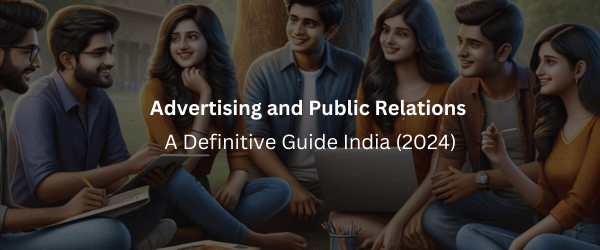
MBA in Public Relations: The Launchpad for Your PR Career
December 8, 2023
Why Public Relations Stands Out in 2024
December 19, 2023For this guide to advertising and public relations, imagine being the voice that shapes consumer choices or the strategist behind a brand’s success story!” This thought is what drives many young Indian graduates towards the dynamic and creative fields of advertising and public relations (PR). These domains are not just about crafting catchy slogans or managing a brand’s image; they’re about understanding human psychology, using creativity to solve problems, and constantly adapting to the ever-changing digital landscape.
Why Choose a Career in Advertising and Public Relations?
Connecting Creativity with Strategy: In advertising, you blend artistic vision with market research to create campaigns that resonate with people. Public relations, on the other hand, is about maintaining and enhancing the image of an organization or individual. Both fields require a unique mix of creativity and strategic thinking.
Digital Revolution: The digital age has transformed these fields. With social media, influencer marketing, and digital analytics, professionals now have innovative ways to reach and engage audiences.
Diverse Opportunities: From working in an ad agency, corporate communications, media houses, to being a part of a non-profit’s outreach program, the opportunities are vast and varied.
Courses to Kickstart Your Career
To dive into these exciting fields, a solid educational foundation is crucial. Here are some courses that can help you get started:
- Bachelor’s in Mass Communication/Journalism: These undergraduate courses provide a broad understanding of media and communication, laying a strong foundation for a career in advertising and PR.
- Postgraduate Diploma in Advertising and Public Relations: This specialized course focuses on the key aspects of advertising and PR, including brand management, media planning, campaign strategy, and more.
- Digital Marketing and Social Media Courses: Given the digital shift, courses focusing on digital marketing, SEO, and social media management are highly beneficial.
- Short-Term Certificate Courses: These are great for those who wish to enhance specific skills like content writing, graphic design, or analytics.
Building Your Skillset: Beyond the Classroom
While courses provide the necessary theoretical knowledge, skills like effective communication, creative thinking, and staying abreast of trends are equally important. Internships, participating in college fests, managing social media for college clubs, or even starting a blog can provide practical experience and exposure. Naturally, this guide to advertising and public relations can also refer you to a more exhaustive skills of needed to succeed in public relations.
Related: Salaries in PR in India
The Path Ahead: PR as a Focused Career
While advertising offers a canvas for creativity, public relations is about strategic communication and relationship building. A career in PR means you could be handling crisis communications, organizing press conferences, building relations with the media, and much more. It’s about being the custodian of a brand’s or individual’s public image.
If the idea of being a communication strategist excites you, then focusing your education and skills towards PR would be the right step. With the evolving landscape of media, the need for skilled PR professionals is more significant than ever.
Embarking on a journey in advertising and PR is not just about choosing a career; it’s about choosing a lifestyle of creativity, continuous learning, and adaptation. The road ahead is as challenging as it is rewarding, but for those with a passion for communication and a drive to innovate, it’s a journey worth taking. We hope this guide to advertising and public relations has been helpful. Read on for more interesting information!
Best institutes offering courses in advertising and public relations in India?
-
School of Communications & Reputation (SCoRe)
-
Xavier’s Institute of Communications (XIC), Mumbai
-
Symbiosis’ Institutes: SIMC, Pune & SSMC, Bangalore
-
Delhi School of Communications (DSC), Delhi
-
Indian Institute of Mass Communications (IIMC), Delhi\
Difference between Advertising and Public Relations
Managing the overall public image of a brand or individual.Costs are generally lower; relies on media coverage and direct communication.
| Aspect | Advertising | Public Relations |
|---|---|---|
| Primary Focus | Promoting products or services. | |
| Communication Method | One-way communication through paid media. | Two-way communication, often through earned media. |
| Control Over Message | High control over content, placement, and timing. | Less control; relies on persuasion and media relations. |
| Audience Reach | Broad, targeting consumers directly. | Targeted; focuses on stakeholders, media, and public opinion. |
| Nature of Content | Creative and persuasive content to drive sales. | Focused on building relationships and trust. |
| Cost | Often involves significant costs for production and media buying. | |
| Measurement of Success | Measured in terms of sales and campaign metrics. | Measured by public perception, media presence, and stakeholder relations. |
| Long-term Impact | Short-term impact focused on immediate sales. | Long-term impact, building brand reputation and public trust. |
| Creative Freedom | High; creativity is central to break through the clutter. | More strategic; requires aligning with brand values and public interests. |
| Response to Market Changes | Quick to adapt to market trends for immediate impact. | Focuses on sustaining a consistent brand image amidst market changes. |
| Crisis Management | Limited role in crisis situations. | Crucial role in managing crises and protecting brand reputation. |
Advantages of Public Relations:
- Strategic Relationship Building: PR excels in establishing and maintaining relationships with key stakeholders, the media, and the public.
- Crisis Management and Image Control: PR professionals are vital in managing crises, protecting and rehabilitating the public image of their clients.
- Long-term Brand Building: Unlike the often short-term focus of advertising, PR is about long-term reputation management.
- Cost-Effectiveness: PR can be more cost-effective, utilizing earned media rather than expensive advertising spots.
- Adaptability to Public Sentiment: PR is more focused on understanding and adapting to public opinion, making it crucial for maintaining a positive public image.



